
Pumiri, the enchanted or petrified city
by Jim Allen.14th November 2002
Way
back in April of 1998, I found myself riding in a jeep with well known
Bolivian archaeologist Oswaldo Rivera and a film team from the BBC.
We were heading towards a site I had picked out from a satellite photo
as a possible Atlantis location,
it was a perfect circle of water about one and a half mile in diameter
located at a site called La Joya which means "the jewel" just north of
the city of Oruro on the Bolivian Altiplano.
It was not possible to tell from the satellite photos exactly what the
site was, so, like all the other potential Atlantis sites on the
Altiplano, it had to be checked out on the ground.
Just then, Oswaldo remembered what it was - "It's a giant slurry tank
for the gold mine" he exclaimed, "I remember now, that's where they
process the water before returning it to the river."
There
did not seem to be much point in continuing after that, but in the
manner of all film teams they did not want to go back empty handed so
we pressed on and filmed the Altiplano from the top of the gold mine.
Oswaldo
had another brainstorm. "I remember there is a lost city around here
somewhere, and it's got ruins, which is what you want to film, but I
can't remember exactly where it is. When we get back to the hotel, I'll
look in the guidebook."
The tiny little guide book produced by the town council in Oruro had this to say.
"The Petrified city of Pumiri - The
enchanting city of Mystery and Time, calls to us with the petrified
voice of the semi-troglodytes; it's streets, avenues, weathered shapes
and caverns await us."
And that was more or less all. But
at least now we knew the name and where it was located, on the northern
edge of the level Altiplano near the village of Turco.
DECEMBER 1998. I had no more expectations of returning to the
Altiplano that year as it was well beyond the "Altiplano season" which I usually
considered August and September.
But I had a call from Atlantic Productions to see if I would be
interested to participate in an Atlantis film and how soon could I travel? My
answer was of course yes, and would tomorrow be soon enough!
A couple of days later the producer and his researcher drove up
from London to see me and were suitably impressed, it remained to see if they could
get the go ahead for a "recce" in advance of filming the following year, also to
check out the climate in Bolivia on the Altiplano at this late time of year
which should have been the wet season.
Some calls followed to Bolivia and to several tour operators
who, when they heard of the proposed route around the desert declined the trip
and told us we would be bogged down in the rains.
Toby, the researcher, in a fit of inspiration, phoned the
police station in Oruro to ask how the weather was. "Fine" came back the reply,
"no problem at all driving around that area."
They made a brave decision and three days later we were off,
flying through Sao Paulo to Buenos Aires then back up to Santa Cruz and landing
once more at El Alto airport in Bolivia.
This time we headed down the Oruro highway as before, but I had
a new route mapped out.
I proposed we turn off the Oruro road and take the
newly constructed metalled highway which heads down towards Volcan Sajama and
continues on into Chile.
We whizzed along, passing some ancient Chulpas or burial
towers which had been brought to the public view by the construction of this new
road and had we continued it would have taken us all the way to Volcan
Sajama.
However I had selected another route over the mountains which
led to the level Altiplano. I knew that moviemen like old ruins to put in their
films, especially if in the quest for lost civilisations, so I wanted to call on
the way at the "Enchanted" or "Petrified" city as it is sometimes called, of
Pumiri.
We turned off the new highway at Curahuara de Carangas, famous
in olden times for its silver mines, passing through the village and seeking the
road over the mountains. We could see formidable rocky mountain tops all around
us, and it was easy to imagine lost ancient hilltop fortifications on all of
them, such as John Blashford-Snell and Oswaldo had found a few miles north of here and which they
had dubbed "Cities of the Eaglemen"
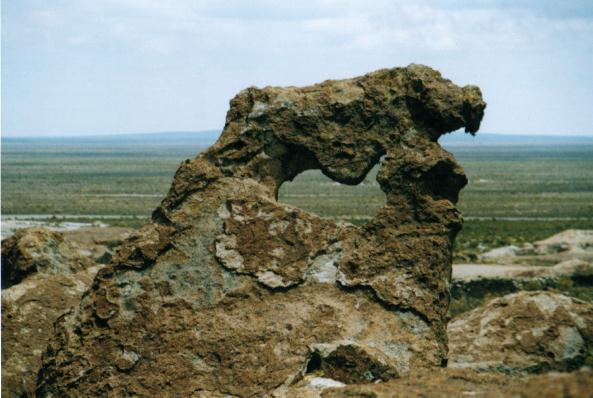
Pumiri bison
The rocks began to take on more fantastic formations, we could
see eagles, pumas, bears, condors, all as if petrified in stone or as if some
ancient unknown race had carved them out of the natural rock which in turn had
been dissolved by the ravages of time, or even some unknown nuclear blast which
had dissolved and melted the rock.
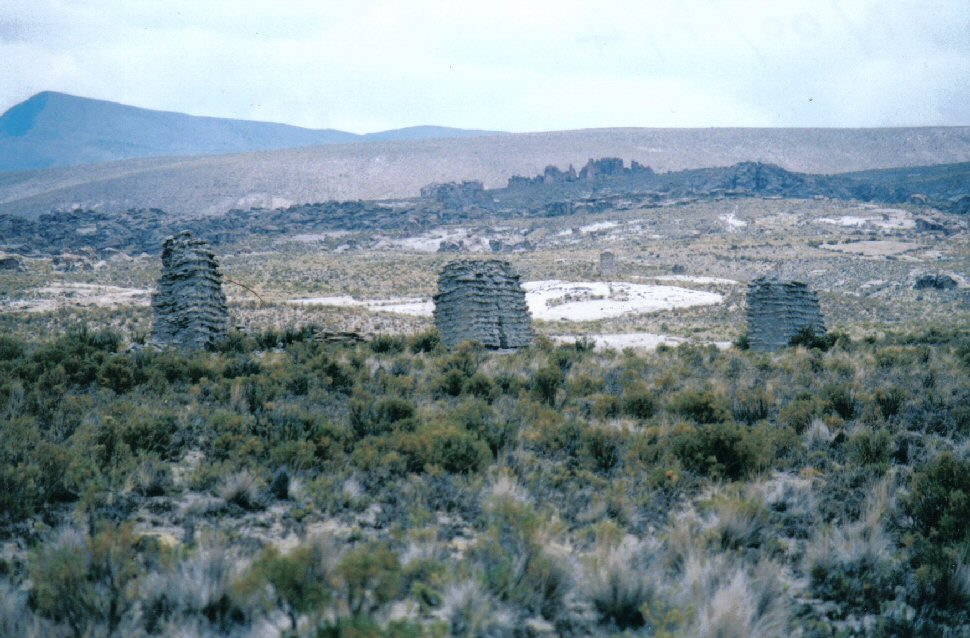
chulpas at Pumiri
We descended into a deep ravine flanked by towering cliffs and
approached a shallow stream which at other times might be a raging torrent.
Thatís why we needed four-wheel drive and even better with two jeeps rather than
one. If only we had the time, we said to ourselves, we would love to stop and
explore. I could imagine the starship "Enterprise" landing here as if on some
alien world, or at least bringing Startrek
itself here as one of its future blockbuster movie sets. (Patrick
Stewart had been approaced to present the film). And what a benefit
that might be also for the people of Bolivia, something more for the
future tourists to think about.
We forded the stream and soon the landscape changed to rolling
hills, everywhere was the sign of long abandoned cultivation even on the most
remote peaks, something we were to notice all around the Altiplano.
We rolled into Turco and pulled up in the main square.
The headmen and elders came out to greet us wearing their
traditional garb and seemed right friendly. Pumiri was nearby, they told us, and
in the morning the guide who happened to be in the village would take us there
and show us around. "Donít go on your own," they advised, "as once you enter,
you will never find the way out."
Notwithstanding the sound advice, we couldnít resist a sneak
preview that evening so we headed out to Pumiri.
The entrance was via the dried up bed of a former river,
guarded on either side by two ancient Chulpas then we were
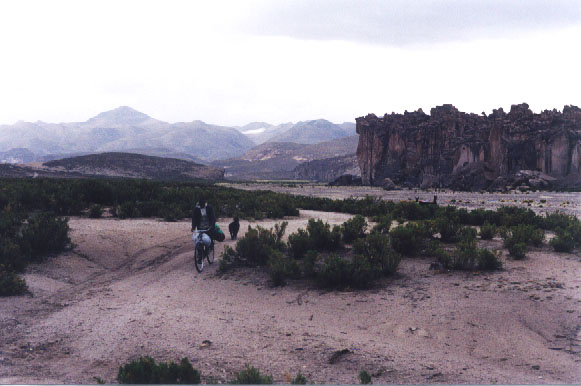
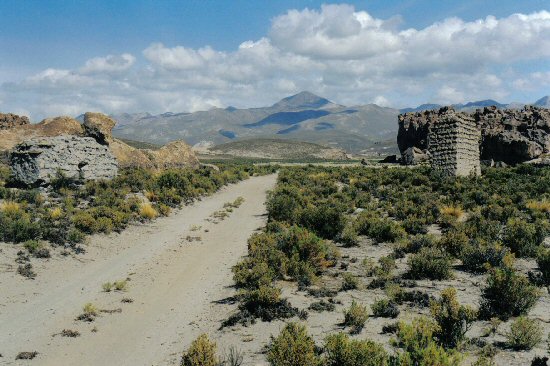
arriving at
Pumiri
inside just as dusk was falling. A time-frozen condor and puma
looked down on us from the petrified stone as we parked the jeep and gazed out
dumbstruck at this most awesome of landscapes.
Well, no, we werenít really thinking of spending the night
there, in a place haunted through aeons of time so we set off back to Turco
wondering if there really was a city there at all, or did they just mean the
stone rocks themselves were the city?
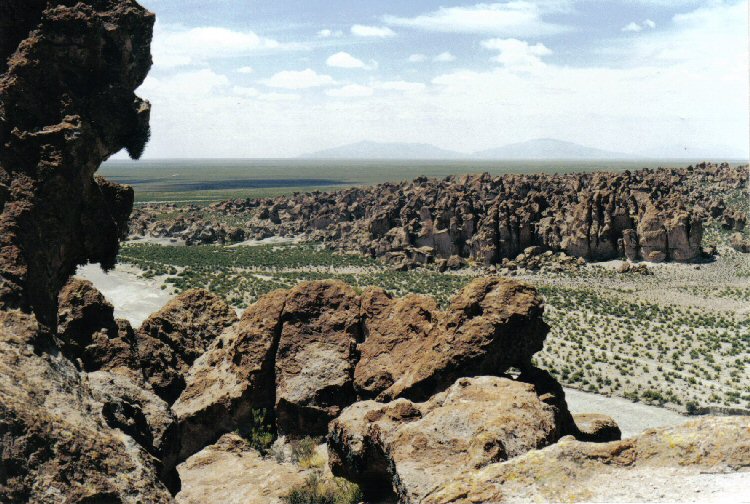
Pumiri
extends over several kilometres of countryside and consists of
naturally weathered rock formations which had been occupied by at least
three different civilisations about which nothing is known, since no
archaeology has been done there and even in La Paz no-one has even
heard of the place. The villager from Turco who found the site kept it
a secret all of his life, and only fairly recently revealed it to his
son on is death bed.
We arrived early in the morning with two of the local guides.
They assured us that there were in fact buildings and very old walls, and we
soon found ourselves in amidst these old walls, the remains of rectangular
houses grouped around little plazas at any convenient spot in amongst the rocks
and cliff tops.
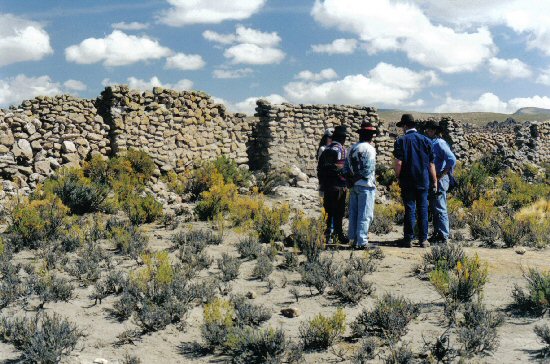
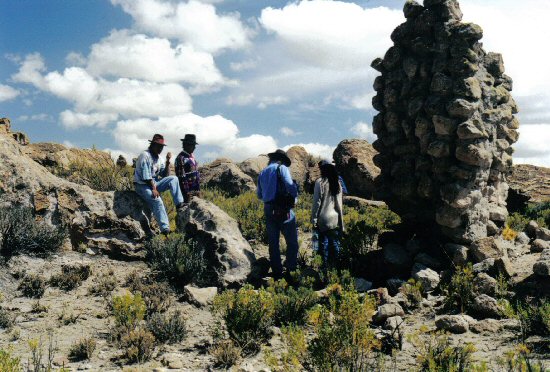
ruined walls at Pumiri
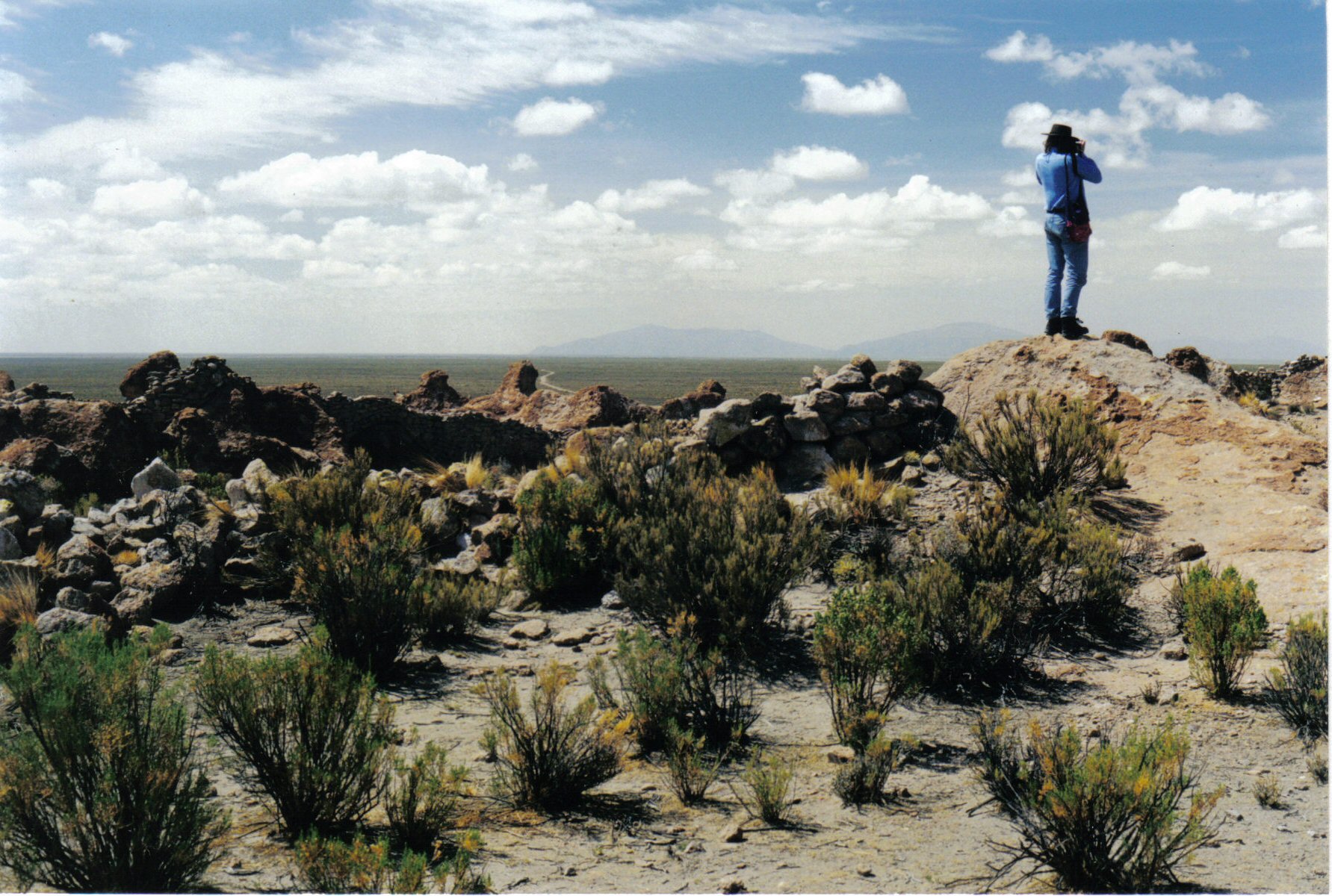
We went on, ever upward and signs of former habitation were all
around.
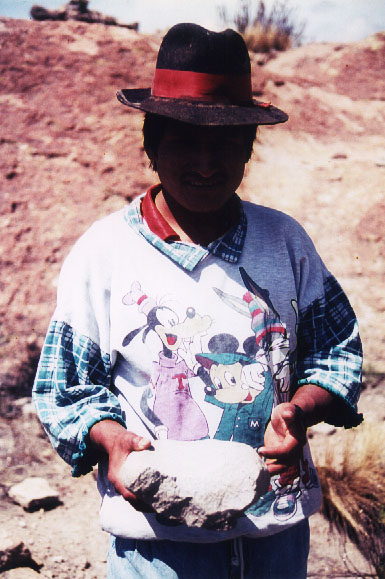 We could imagine the estate agent of the day offering a particular
hollow in the rocks as a most desirable residence which indeed it was, with
elevated views over the surrounding landscape which were literally breathtaking
and in amongst the rocks themselves were circular holes like windows gazing out
on the surroundings, probably naturally formed, or were they the work of man? A
stone carved basin set in the ground suggested a former grinding place for some
substance and one of the guides picked up the remains of a stone bowl in his
hands.
We could imagine the estate agent of the day offering a particular
hollow in the rocks as a most desirable residence which indeed it was, with
elevated views over the surrounding landscape which were literally breathtaking
and in amongst the rocks themselves were circular holes like windows gazing out
on the surroundings, probably naturally formed, or were they the work of man? A
stone carved basin set in the ground suggested a former grinding place for some
substance and one of the guides picked up the remains of a stone bowl in his
hands.
Broken pottery was everywhere and fragments were collected to
be taken back to Oruro for presentation to the archaeologists.
Alas the carefully collected treasure had an unhappy fate. Days
later in Oruro Clive and Toby spread the pottery out on the floor of their hotel for
further study then popped off to the bar for a drink. On their return they found
the fragments gone Ė the maid had serviced the room and swept them up, throwing
them into the dustbin. A frantic search of all the dustbins proved to be of no
avail, personally I found it hilarious!
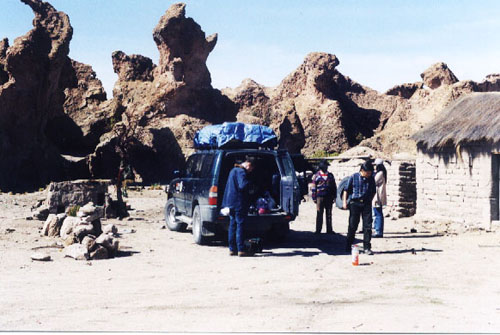
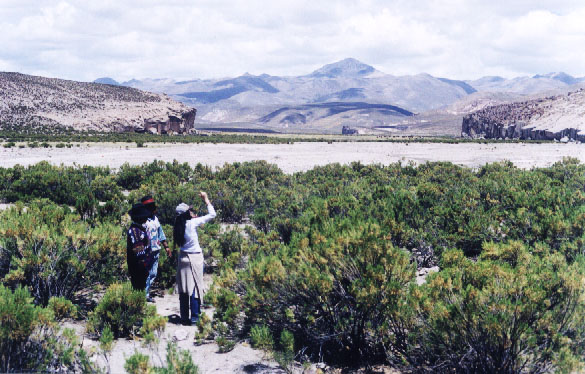
arriving at Pumiri, the
girls take in the view of the valley
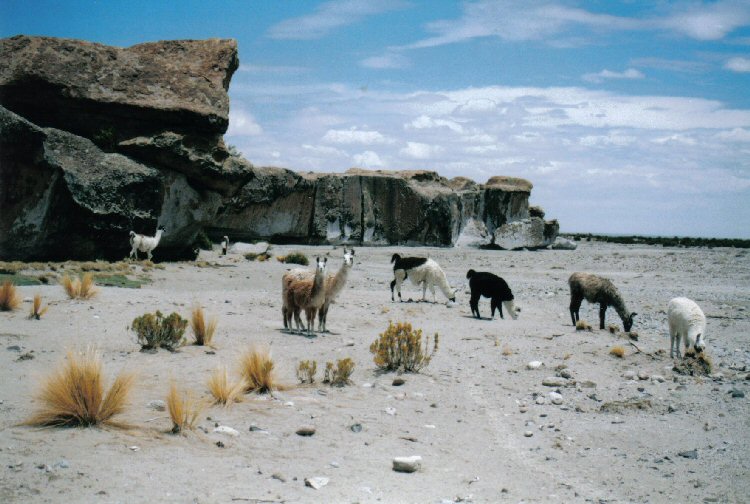
the present inhabitants of
Pumiri
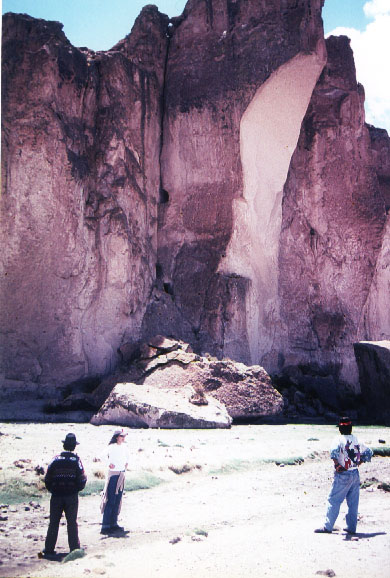
Entrance through the hole cut in the rock face
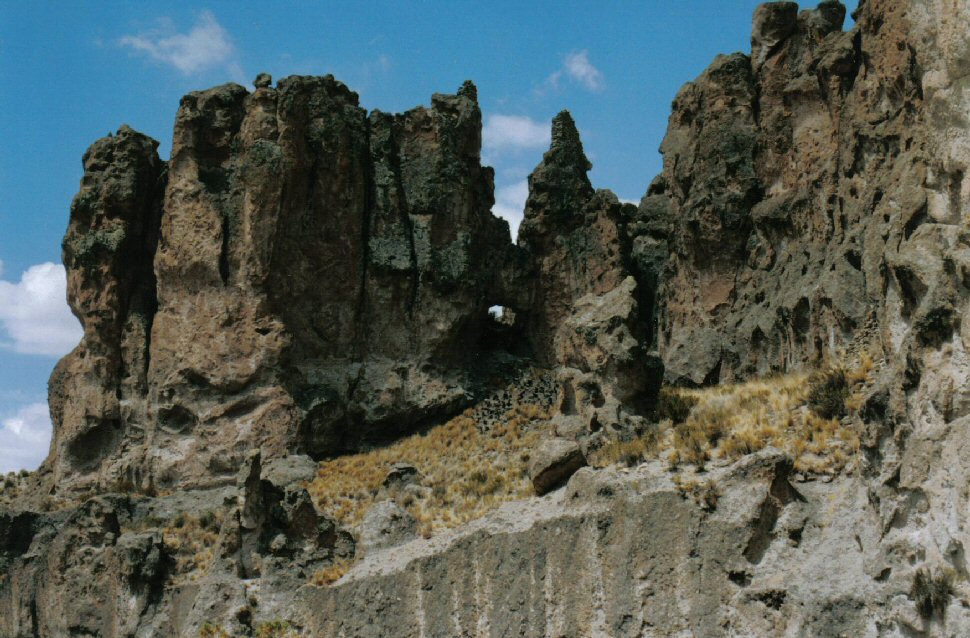
people lived in ancient times amongst the rock formations

view of the valley from
the heights of Pumiri
We
never did present those fragments to the archaeologists to study and
Pumiri remains as little known today as it was four years ago when I
first went there.
We only had the "short" or quick tour of the site, but it extends ever
upwards amongst the rocks
complete with it's caverns, time-frozen condors and remains of those
mysterious subterranean troglodytes; perhaps one day we will bring a
film and archaeology team to write the history of this mysterious place
for posterity.
sailing to Atlantis

atlantisbolivia.org









 We could imagine the estate agent of the day offering a particular
hollow in the rocks as a most desirable residence which indeed it was, with
elevated views over the surrounding landscape which were literally breathtaking
and in amongst the rocks themselves were circular holes like windows gazing out
on the surroundings, probably naturally formed, or were they the work of man? A
stone carved basin set in the ground suggested a former grinding place for some
substance and one of the guides picked up the remains of a stone bowl in his
hands.
We could imagine the estate agent of the day offering a particular
hollow in the rocks as a most desirable residence which indeed it was, with
elevated views over the surrounding landscape which were literally breathtaking
and in amongst the rocks themselves were circular holes like windows gazing out
on the surroundings, probably naturally formed, or were they the work of man? A
stone carved basin set in the ground suggested a former grinding place for some
substance and one of the guides picked up the remains of a stone bowl in his
hands.





